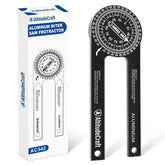Ultimate Guide to Metric and Imperial Thread Gauge
Ultimate Guide to Metric and Imperial Thread Gauge
Accurate thread measurement is critical in various fields, from construction to vehicle maintenance. Incorrect thread sizing can lead to issues such as improper fitting, reduced strength, and potential damage. The AltitudeCraft Nut and Bolt Thread Checker offers a seamless solution by combining the benefits of both Metric and Imperial thread gauges, ensuring precision for the DIY enthusiast and professional alike.
Introduction to the Importance of Accurate Thread Measurement
Thread measurement is a fundamental task in both small-scale DIY projects and large-scale manufacturing processes. Using the right tools, such as a precise bolt size gauge, can save time and prevent costly mistakes. From nuts and bolts fitting properly to the integrity of assembled parts, the accuracy of thread measurements impacts the entire operation.
Overview of Metric and Imperial Thread Gauges
Thread gauges come in two primary types: Metric and Imperial. Metric gauges measure threads in millimeters, while Imperial gauges use inches. Each type serves specific applications, and understanding their differences is crucial for accurate hardware measurement.
- Metric Gauges: Commonly used in Europe and in technical projects.
- Imperial Gauges: Predominantly used in the United States for general applications.
Features of the AltitudeCraft Nut and Bolt Thread Checker
The AltitudeCraft tool boasts unmatched precision, utilizing high-quality materials like SUS304 stainless steel and 6061 aluminum. It covers 28 sizes, from Metric thread sizes M4 x 0.7 to M14 x 2.0 and Standard threads from #6-32 Coarse to 1/2-20 Fine, making it an essential piece in your toolkit.
Step-by-Step Guide: How to Use the Thread Gauge Effectively
Here’s how you can effectively use the AltitudeCraft thread gauge for accurate results:
- Select the Proper Gauge: Identify whether Metric or Imperial measurements are needed.
- Align the Threads: Gently screw the bolt into the gauge, ensuring that the threads match perfectly.
- Confirm Fit: Ensure there's no wobble or gap, indicating a proper match.
Comparison of Metric vs Imperial Thread Sizes and Their Uses
Choosing between metric and imperial threads depends on your project requirements. Metric measurements are ideal for precision applications, while imperial threads are widely used for everyday hardware tasks. Consider your geographic location and project type when selecting a system.
Common Mistakes in Thread Measurement and How to Avoid Them
Avoid these common pitfalls in thread measurement to ensure accuracy:
- Using the Wrong Gauge Type: Confirm whether you require metric or imperial measurements.
- Ignoring Tolerances: Be aware of the tolerance levels that affect fit and quality.
- Skipping Calibration: Regularly calibrate your thread gauge to maintain its precision.
Maintenance Tips for Your Thread Gauge to Ensure Longevity
To keep your thread gauge functioning at its best, follow these maintenance tips:
- Regular Cleaning: Wipe the gauge after each use to remove dust and debris.
- Proper Storage: Keep the gauge in a dry place to prevent corrosion.
- Routine Calibration: Check the accuracy periodically to ensure reliable measurements.
Conclusion: Choosing the Right Thread Gauge for Your Needs
Whether you're a professional or a DIY enthusiast, selecting the right Metric and Imperial thread gauges can profoundly impact your projects. With its precision and durability, the AltitudeCraft Nut and Bolt Thread Checker is a reliable companion for all hardware measurement tasks. It’s versatile, easy to use, and built to last, making it an essential addition to any toolkit.
FAQs
Q1. What is the difference between Metric and Imperial thread gauges?
Metric thread gauges use millimeters, suitable for precision projects, while Imperial gauges utilize inches and are common in general applications.
Q2. How accurate is the AltitudeCraft Nut and Bolt Thread Checker?
The AltitudeCraft Thread Checker offers a measurement accuracy of +/- 0.02 inches, ensuring precise fittings.
Q3. How do I maintain my thread gauge for accurate use?
Regular cleaning, proper storage, and consistent calibration are essential to maintaining accuracy and longevity of your thread gauge.
Q4. Can I use this thread gauge for both professional and DIY projects?
Yes, the AltitudeCraft Nut and Bolt Thread Checker is designed for a wide range of applications, from professional to DIY tasks.















Leave a comment
All blog comments are checked prior to publishing